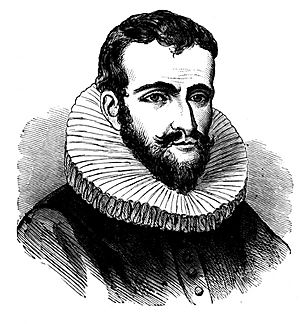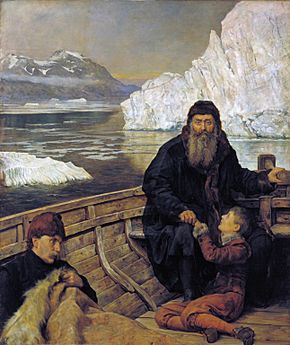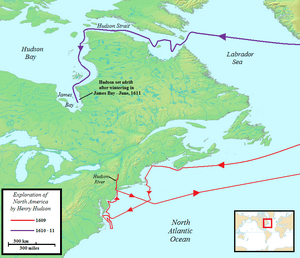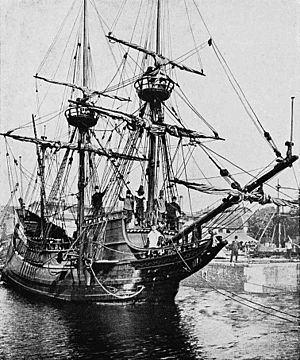Henry Hudson facts for kids
Quick facts for kids
Henry Hudson
|
|
|---|---|

One of many speculative portraits
|
|
| Born | c. 1565 |
| Disappeared | 23 June 1611 (aged 45–46) James Bay, North America |
| Other names | Hendrick Hudson |
| Occupation | Sea explorer, navigator |
| Years active | 1607–1611 (as explorer) |
| Employer | |
| Known for |
|
| Children | John Hudson (c. 1591–1611) |
Henry Hudson (born around 1565 – disappeared 23 June 1611) was an English sea explorer and navigator. He lived in the early 1600s. He is famous for exploring parts of what are now Canada and the northeastern United States.
In 1607 and 1608, Hudson tried to find a new sea route. English merchants hired him to find a Northeast Passage to Asia. This route was thought to go over the top of the world, near the Arctic Circle. In 1609, he explored the area around modern New York City for the Dutch East India Company. He sailed up the Hudson River, which was later named after him. This helped the Dutch start colonies in that region.
On his last trip, Hudson was still looking for a Northwest Passage to Asia. He was the first European to see Hudson Strait and the huge Hudson Bay. In 1611, after spending the winter in James Bay, most of his crew rebelled. They left Hudson, his son, and six other men adrift in a small boat. Henry Hudson and his companions were never seen again.
Contents
Henry Hudson's Early Life
We don't know much for sure about Henry Hudson's early life. He was likely born in London, England, sometime between 1560 and 1570. When he first appeared in historical records in 1607, he was already an experienced sailor. He was trusted enough to lead an expedition. His mission was to find a trade route across the North Pole.
Hudson's Famous Expeditions
Searching for a Northern Route (1607 and 1608)
In 1607, the Muscovy Company in England hired Hudson. They wanted him to find a northern sea route to the Pacific Ocean and Asia. People thought that because the sun shone all summer in the far north, the ice might melt. This would allow a ship to sail across the "top of the world."
On May 1, 1607, Hudson set sail on a ship called the Hopewell. He had a crew of ten men and one boy. They reached the east coast of Greenland and sailed north. They then turned east and saw land that is now Spitsbergen. On July 16, they reached very far north, but thick ice blocked their way. They had to turn back south. The expedition returned to England in September.
Hudson reported seeing many whales in the waters near Spitsbergen. This led to other countries sending ships to hunt whales there.
In 1608, English merchants sent Hudson on the Hopewell again. This time, they wanted him to find a passage to Asia by going east around northern Russia. They left London in April and sailed far north to Novaya Zemlya. But even in summer, they found the ice too thick to pass. They turned back and arrived in England in August.
Exploring North America (1609)
In 1609, merchants from the Dutch East India Company in the Netherlands chose Hudson. They wanted him to find an eastern passage to Asia. While waiting in Amsterdam, Hudson heard rumors of a western route through North America. His original orders were to sail north of Russia. But because ice blocked that way, he changed his plan.
In mid-May, he turned his ship, the Halve Maen (meaning "Half Moon"), west. He decided to look for a passage through North America instead. On July 2, they reached the Grand Banks of Newfoundland. In mid-July, they landed near Nova Scotia in Canada. Here, they met Indigenous peoples in Canada who traded beaver pelts. The crew stayed for about ten days, fixing their ship and fishing. On July 25, some of Hudson's crew went ashore and had a conflict with a village. They took a boat and other items.
On September 3, Hudson reached the mouth of a large river. This river was first called the "North River" but is now known as the Hudson River. He was not the first European to see it, but his exploration was very important. On September 11, he sailed into the Upper New York Bay. The next day, he met a group of 28 Lenape canoes. He traded with them for oysters and beans.
Over the next ten days, his ship sailed far up the river. A small boat with five crew members went even further, near what is now Albany, New York. On September 23, Hudson decided to return to Europe. He stopped in England in November. His voyage helped the Dutch claim the region. It also led to a successful fur trade there. Later, New Amsterdam (now Manhattan Island) became the capital of New Netherland.
The Final Voyage and Mutiny (1610–1611)
In 1610, Hudson got support for another voyage, this time from England. He sailed his new ship, the Discovery. He reached Iceland in May and Greenland in June. On June 25, the explorers reached what is now the Hudson Strait. On August 2, the ship entered Hudson Bay. Everyone was excited, thinking they had found the Northwest Passage.
Hudson spent months exploring the eastern shores of the bay. But he and his crew did not find a passage to Asia. In November, the ship got stuck in the ice in James Bay. The crew had to spend the winter ashore.
The Mutiny
When the ice melted in the spring of 1611, Hudson wanted to keep exploring. He still hoped to find the Passage. However, most of his crew wanted to go home. In June, many of the crew rebelled. The only people who survived to tell the story were the mutineers.
One survivor, the ship's navigator Abacuk Pricket, kept a journal. According to Pricket, the main leaders of the mutiny were Henry Greene and Robert Juet. The mutineers put Hudson, his teenage son John, and seven other crewmen into a small open boat called a shallop. These men were either sick or loyal to Hudson. They were left behind in Hudson Bay. The mutineers gave them some clothes, powder, shot, food, and other items.
Hudson's Disappearance

After the mutiny, Hudson's small boat tried to follow the Discovery. But the mutineers soon sailed away, leaving the small boat behind. Henry Hudson and the seven others in the shallop were never seen again. People searched for them later, but their fate remains unknown.
Only eight of the thirteen mutineers survived the trip back to Europe. They were arrested in England. Some were put on trial, but no one was punished for the mutiny. One idea is that they were too valuable for their knowledge of the New World to be executed.
Later Discoveries and Stories
In 1612, a man named Nicolas de Vignau claimed he saw parts of an English ship on the shores of James Bay. This was not believed at the time, but some historians now think it might be true.
A Canadian author, Dorothy Harley Eber, collected stories from the Inuit people. She thought these stories might be about Hudson and his son after the mutiny. The Inuit told of an old man with a long white beard and a young boy arriving in a small wooden boat. The Inuit had never seen white people before. They took them in and fed them. After the old man died, the Inuit kept the boy with them. These stories are similar to how Inuit testimonies helped find the lost ships of Franklin's lost expedition much later.
In the late 1950s, a 150-pound stone was found near Deep River, Ontario. It had carvings of Hudson's initials (H. H.), the year 1612, and the word "captive." While the letters matched maps from the 1600s, experts could not say when the carving was made.
Hudson's Lasting Legacy
The huge Hudson Bay and Hudson Strait in Canada are named after Henry Hudson. This bay is three times the size of the Baltic Sea. Its many large rivers allowed access to parts of Western Canada and the Arctic that were otherwise hard to reach. This helped the Hudson's Bay Company become very powerful. They traded furs along the bay's shores for over two hundred years. This company even influenced the borders of western North America.
Many other places are also named after Hudson. These include the Hudson River in New York and New Jersey. Also, Hudson County, New Jersey, the Henry Hudson Bridge, the Henry Hudson Parkway, and the city of Hudson, New York are named in his honor.
See also
 In Spanish: Henry Hudson para niños
In Spanish: Henry Hudson para niños



